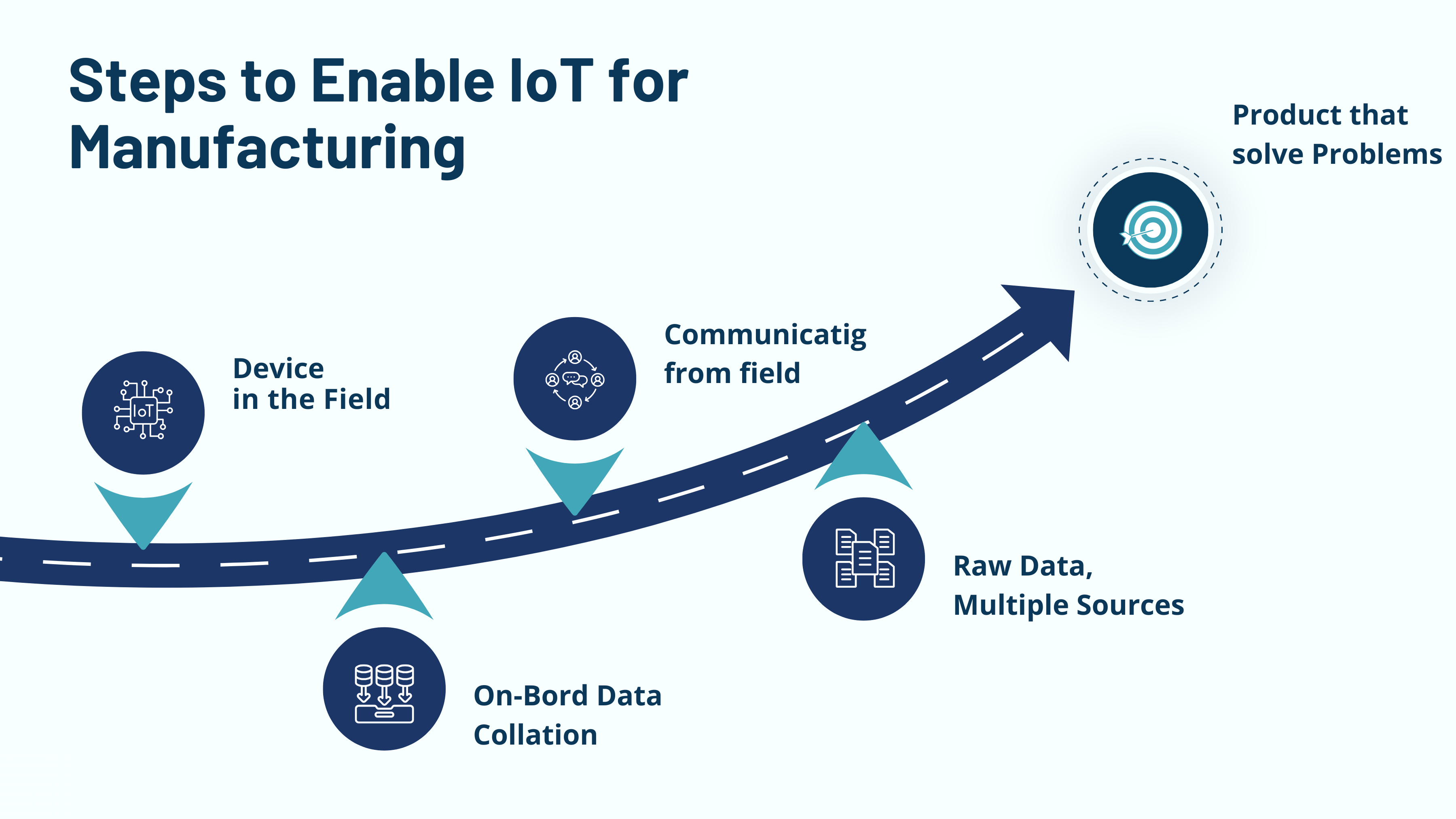Thought Leader: Koras Ajwaliya
The Internet of Things has emerged as a significant technology in the transforming digital landscape for all businesses. IoT is also pivotal solution for Manufacturing enterprises that are always under pressure to improve operational processes and reduce cost. Smart IoT Solutions is redefining how manufacturers operate and communicate through real-time data. The Internet of Things for manufacturing involves a network of sensor-integrated machines and systems that gather and exchange data in real time, with effective communication between various devices. Manufacturing harnesses IoT capabilities to improve quality control, enhance productivity, harness predictive maintenance and efficient management.
Let us see in detail how the Manufacturing Industry can harness the transformational capabilities of smart Internet of Things solutions and reap limitless potential in innovation, operational efficiency, and cost reduction.
What is IoT for Manufacturing?
The “Internet of Things” powered manufacturing systems are fully connected devices and sensors to the Internet. It enables enterprises to collect and exchange real-time data across production processes to process-related problems that can be taken care of at the right time.
One example of IoT adoption in manufacturing is mass customization. It requires an increase of different tools and products resulting in varied inventory. As a real-time data hub, IoT facilitates mass customization through techniques like scheduling and forecasting based on the specific requirements and preferences of the individual customer. There are huge amounts of data from sensors that manufacturers can tap into to create customized products and deliver them at the right moment with unprecedented accuracy.
Key IoT Technologies for Manufacturing
Sensors: Equipment that measures the performance of machines (temperature, vibration, speed, ) and initiates automatic actions (such as shutting off a breakdown machine or adjusting settings).
Cloud Computing: Centralized data storage and analysis platforms where IoT data is aggregated, stored, and processed.
Edge Computing: Processing data closer to the source, such as on the factory floor, to reduce latency and enable real-time decision-making.
Learn More: Enterprise IoT: Business Advancement Solution
Connectivity (5G, Wi-Fi, Bluetooth): High speed networks that streamline data transfer between devices with no interruption.

Benefits of IoT for Manufacturing
Seamless automation and real-time insights increase efficiency and productivity.
Proactive maintenance minimizes downtime, thus enhancing smooth operations.
Improved quality control and innovative design of products through data-driven decision-making.
Unprecedented supply chain visibility through real-time tracking and analytics of data.
Enhanced worker safety as the IoT devices monitor and mitigate risks on the shop floor.
High inventory management savings and reduction of waste, utilizing resources fully at
each point.
The implementation of smart IoT solutions in manufacturing not only saves process-related issues but also reveals a new performance level along with sustainability.
Transformative Capabilities of IoT for Manufacturing Enterprises
Preventive Maintenance
Preventive Maintenance is the most efficient application for manufacturers to avoid Unlike the traditional approach that relied on scheduled maintenance, IoT enabled devices constantly track and monitor performance provided data metrics like temperature, vibration, pressure, motor speed and more. This data, based on machine learning algorithms, predicts when a machine may fail or require maintenance; thus, manufacturers can prepare for repairs before it occurs. This preventive approach saves downtime, increases the age of equipment, and diminishes the cost of unscheduled repairs. It is a win for both operations and the bottom line.
Real Time Monitoring & Data Analysis
IoT allows manufacturers to collect real-time data from machines, production lines, and workers. That information is not only helpful for maintenance but also action-oriented to optimize production processes. Managers can track everything from inventory levels to energy consumption and machine performance across multiple locations or factories using IoT-enabled systems.
Analyzing that information in real-time allows manufacturers to:
Spot Inefficiencies: Bottlenecks, delays, and underperforming equipment can be identified.
Workflow Optimization: Resource re-alignment, according to live data streams, to ensure smooth flow of operations.
Quality of Products: Immediate real-time quality control inspection would highlight defects or anomalies in the products so that defective products cannot be shipped to
With the integration of advanced data analytics and machine learning within the IoT systems, deeper insights are gained, thereby supporting data-driven decisions that may enhance productivity, decrease waste, and improve operational agility.
Quality Control
Quality problems will be detected sooner if case smart manufacturers trace their products closely throughout production. It means rapid corrective action on the one hand, but on the other, this provides valuable insights into improving product design, leading to continuous improvement with superior results.
Supply Chain Management
The supply chain serves as the backbone of most manufacturing operations, and the Internet of Things is making them smarter and more agile. IoT sensors and RFID tags help manufacturers track inventory, monitor the movement of goods, and ensure real-time updates on status shipments, all of which contribute to a more transparent and responsive supply chain.
IoT-enabled supply chains can help manufacturers in the following:
Real-Time Inventory Tracking: Automatically ordering parts or materials when they run low to avoid stockouts or overstocking.
Logistics Optimization: Track deliveries and shipments to ensure timely delivery of materials in the right places.
Agility: Instant adaptation to supply chain disruption or changes in demand as it has real-time information on available resources and their levels.
In the end, IoT simplifies operations and decreases lead times, allowing manufacturers to be more responsive to market demand.
Learn More: Transforming Asset Management with IoT in Asset Monitoring
Smart IoT Solutions for Manufacturing and Automation
The other fascinating development that IoT for manufacturing is enabling is the rise of smart factories. These are very highly automated and connected production environments that use all sorts of IoT technologies to optimize every part of manufacturing, from inventory and supply chain management all through to product design and production. In a smart factory:
Cobots: Robots and machines can collaborate with humans, performing repetitive tasks and freeing up human workers for more complex or value-added activities.
Automated production lines that adapt based on real-time data inputs improve flexibility and
Quality assurance systems automatically detect defects or deviations from the desired product specifications, enabling faster corrections.
By integrating IoT with AI/ML, and Robotics, manufacturers can reach the next-level automation which maximizes efficiency and produces quality products.
Improve Worker Safety
Worker safety always remains a priority in manufacturing environments, and IoT for manufacturing is helping companies take proactive measures to ensure a safer workplace. IoT-powered wearables monitor workers’ health and well-being, detecting hazardous conditions like excessive heat, dangerous gas levels, fatigue, etc.
Moreover, IoT-enabled safety systems can Monitor environmental conditions, track worker location, and Enhance compliance.
With the reduction of workplace accidents and a safer working environment, smart IoT solutions foster a culture of safety and well-being, which is critical for operational efficiency.
Tech Giants Paving the Road for the Future of IoT
While Industrial IoT is still an emerging technology in manufacturing, it already is causing quite an effect, and not just manufacturing people are talking about. Tech leaders are pouring in billions to try and establish
themselves as leaders of the digital revolution of the manufacturing sector. Consider the following example:
Microsoft developed Azure IoT Suite for Manufacturing to provide manufacturers with deep data
Amazon has not been behind the race and has also released AWS IoT Greengrass for Manufacturing. This is an extremely handy platform that lets people work effortlessly to control and manage devices as well as process data in real time.
Google developed the innovative Cloud IoT Core that provides an efficient way of analysing data for manufacturers on IoT scales.
These cutting-edge platforms are revolutionizing the way manufacturers collect, analyse, and leverage machine data, streamlining operations and driving innovation across the industry.
Transformative Impact of IoT on Manufacturing Enterprise
IoT enabled devices make manufacturing enterprises more agile and responsive in the transforming landscape. For manufacturers that aim to stay ahead of the competition, investment in IoT technologies is no longer an option but a necessity. The more the IoT ecosystem continues to evolve, the more those embracing it will be better positioned to navigate the challenges of the manufacturing landscape tomorrow.
Manufacturing is going connected, intelligent, and IoT-powered and it is happening now.
Want to get started with IoT? Contact Stridely Solutions and embark on a journey towards a smarter, more connected future.


